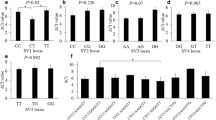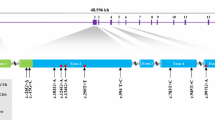Abstract
As a component of E3 ubiquitin protein ligases called SCFs, SKP2 protein belongs to a member of FBLs protein which is the biggest eukaryotic subfamily of F-BOX proteins with 12 members. In this study, we cloned and sequenced partial cDNA, intron 1 and intron 6 of porcine SKP2 gene. The partial cDNA is 1,402 bp long and has an open reading frame of 1,272 bp which encodes 424 putative amino acids. The deduced protein comprises a conserved F-BOX domain at position from the 90th to 140th amino acid. The phylogenetic tree indicated that porcine SKP2 has the closest genetic relationship with bovine SKP2 than other selected animal species. Quantitative RT-PCR analysis displayed that the tissue expression level of porcine SKP2 fluctuated remarkably in a large range, and it expressed in thymus with the highest level and in longissimus dorsi muscle with the lowest level. Two SNPs were identified, meanwhile, further polymorphism analysis with Cfr42I showed that AA genotype was in dominance absolutely among four kinds of unrelated Chinese indigenous miniature and one introduced Landrace pig breeds. In addition, association analysis with immune traits and blood parameters revealed that the SNP Cfr42I in intron 1 was significantly associated with red cell distribution width of neonate piglets at 0 day (P = 0.027).






Similar content being viewed by others
References
Weissman AM (1997) Regulating protein degradation by ubiquitination. Immunol Today 18:189–198. doi:10.1016/S0167-5699(97)84666-X
Hershko A, Ciechanover A (1998) The ubiquitin system. Annu Rev Biochem 67:425–479. doi:10.1146/annurev.biochem.67.1.425
Bai C, Sen P, Mathias N, Hofmann K, Ma L, Goebl M, Harper JW, Elledge SJ (1996) SKP1 connects cell cycle regulators to the ubiquitin proteolysis machinery through a novel motif, the F-BOX. Cell 86:263–274. doi:10.1016/S0092-8674(00)80098-7
Skowyra D, Craig KL, Tyers M, Elledge SJ, Wade Harper J (1997) F-Box proteins are receptors that recruit phosphorylated substrates to the SCF ubiquitin-ligase complex. Cell 91:209–219. doi:10.1016/S0092-8674(00)80403-1
Feldman RM, Correll CC, Kaplan KB, Deshaies RJ (1997) A complex of Cdc4p, Skp1p, and Cdc53p/cullin catalyzes ubiquitination of the phosphorylated CDK inhibitor Sic1p. Cell 91:221–230. doi:10.1016/S0092-8674(00)80404-3
Winston JT, Koepp DM, Zhu C, Elledge SJ, Wade Harper J (1999) A family of mammalian F-BOX proteins. Curr Biol 9:1180–1182. doi:10.1016/S0960-9822(00)80021-4
Cenciarelli C, Chiaur DS, Guardavaccaro D, Parks W, Vidal M, Pagano M (1999) Identification of a family of human F-BOX proteins. Curr Biol 9:1177–1179. doi:10.1016/S0960-9822(00)80020-2
Bloom Joanna, Pagano Michele (2003) Deregulated degradation of the cdk inhibitor p27 and malignant transformation. Semin Cancer Biol 13:41–47. doi:10.1016/S1044-579X(02)00098-6
Tsvetkov LM, Yeh K-H, Lee S-J, Sun H, Zhang H (1999) P27Kip1 ubiquitination and degradation is regulated by the SCFSkp2 complex through phosphorylated Thr187 in p27. Curr Biol 9:661–666. doi:10.1016/S0960-9822(99)80290-5
Nakayama K, Nagahama H, Minamishima YA, Miyake S, Ishida N, Hatakeyama S, Kitagawa M, Shun-ichiro I, Natsume T, Nakayama KI (2004) Skp2-mediated degradation of p27 regulates progression into mitosis. Dev Cell 6:661–672. doi:10.1016/S1534-5807(04)00131-5
von der Lehr N, Johansson S, Wu S, Bahram F, Castell A, Cetinkaya C, Hydbring P, Weidung I, Nakayama K, Nakayama KI, Söderberg O, Kerppola TK, Larsson L-G (2003) The F-Box protein Skp2 participates in c-Myc proteosomal degradation and acts as a cofactor for c-Myc-regulated transcription. Mol Cell 11:1189–1200. doi:10.1016/S1097-2765(03)00193-X
Zhao D, Gaixia Z, Dongmei Y, Xin Z, Ya G (2008) Molecular mechanism of Skp2 in promoting cervical cancer HeLa cell proliferation. J Med Coll PLA 23:199–208. doi:10.1016/S1000-1948(08)60043-X
Cardozo T, Pagano M (2004) The SCF ubiquitin ligase: insights into a molecular machine. Nat Rev Mol Cell Biol 5:739–751. doi:10.1038/nrm1471
Glickman MH, Ciechanover A (2002) The ubiquitinproteasome proteolytic pathway: destruction for the sake of construction. Physiol Rev 82:373–428
Scheffner M, Huibregtse JM, Vierstra RD, Howley PM (1993) The HPV-16 E6 and E6-AP complex functions as an ubiquitin-protein ligase in the ubiquitination of p53. Cell 75:495–505. doi:10.1016/0092-8674(93)90384-3
Harty RN, Brown ME, McGettigan JP, Wang G, Jayakar HR, Huibregtse JM, Whitt MA, Schnell MJ (2001) Rhabdoviruses and the cellular ubiquitin-proteasome system: a budding interaction. J Virol 75:10623–10629. doi:10.1128/JVI.75.22.10623-10629.2001
Winberg G, Matskova L, Chen F, Plant P, Rotin D, Gish G, Ingham R, Ernberg I, Pawson T (2000) Latent membrane protein 2A of Epstein-Barr virus binds WW domain E3 protein-ubiquitin ligases that ubiquitinate B-cell tyrosine kinases. Mol Cell Biol 20:8526–8535. doi:10.1128/MCB.20.22.8526-8535.2000
Coscoy L, Sanchez DJ, Ganem D (2001) A novel class of herpesvirus-encoded membrane-bound E3 ubiquitin ligases regulates endocytosis of proteins involved in immune recognition. J Cell Biol 155:1265–1273. doi:10.1083/jcb.200111010
Bour S, Perrin C, Akari H, Strebel K (2001) The human immunodeficiency virus type I Vpu protein inhibits NF-jB activation by interfering with bTrCP-mediated degradation of IjB. J Biol Chem 276:15920–15928. doi:10.1074/jbc.M010533200
Kalra N, Kumar V (2006) The X protein of hepatitis B virus binds to the F-BOX protein Skp2 and inhibits the ubiquitination and proteasomal degradation of c-Myc. FEBS Lett 580:431–436. doi:10.1016/j.febslet.2005.12.034
Kumar V, Sarkar DP (2004) Hepatitis B virus X protein: structure-function relationships and role in viral pathogenesis. In: Triezenberg SJ, Kaufman J, Gossen M (eds) Handbook of Experimental Pharmacology. Springer-Verlag, Berlin, pp 377–407
Nakayama KI, Nakayama K (2005) Regulation of the cell cycle by SCF-type ubiquitin ligases. Semin Cell Dev Biol 16:323–333. doi:10.1016/j.semcdb.2005.02.010
Wu X, Yu M, Liu B, Yerle M, Zhao SH, Wang YF, Fan B, Li K (2004) Mapping of three porcine 20S proteasome genes using the IMpRH panel. Cytogenet Genome Res 106:142. doi:10.1159/000078566
Wang HL, Zhu ZM, Wang H, Yang SL, Zhao SH, Li K (2006) Molecular characterization and association analysis of porcine CA3. Cytogenet Genome Res 115:129–133. doi:10.1159/000095232
Wang H, Wang H, Zhu Z, Yang S, Feng S, Li K (2007) Characterization of porcine EPLIN gene revealed distinct expression patterns for the two isoforms. Anim Biotechnol 18:101–108. doi:10.1080/10495390600864660
Shan TL, Li K, Tang ZL, Yang SL, Ma YH, Guan WJ, Guo DZ (2008) Full-length coding sequences, polymorphism and chromosomal localizations of the porcine EDG4 and EDG7 genes. Mol Biol Rep 36:751–756. doi:10.1007/s11033-008-9239-y
Ma G, Huang J, Sun N, Liu X, Zhu M, Wu Z, Zhao S (2008) Molecular characterization of the porcine GBP1 and GBP2 genes. Mol Immunol 45:2797–2807. doi:10.1016/j.molimm.2008.02.007
Cavaliere TerriA, MS RNC, NP N (2004) Clinical practice red blood cell indices: implications for practice. Newborn Infant Nurs Rev 4:231–239. doi:10.1053/j.nainr.2004.09.006
Hadler MCCM, Colugnati FAB, Sigulem DM (2004) Risks of anemia in infants according to dietary iron density and weight gain rate. Prev Med 39:713–721. doi:10.1016/j.ypmed.2004.02.040
Blomberg DJ, Guth JL, Fattu JM, Patrick EA (1986) Evaluation of a new classification system for anemias using consult learning system. Comput Methods Programs Biomed 22:119–125. doi:10.1016/0169-2607(86)90101-X
Evans TC, Jehle D (1991) The red blood cell distribution width. J Emerg Med 9:71–74. doi:10.1016/0736-4679(91)90592-4
Acknowledgments
This work was supported by the National 973 Program (2006CB102105), National 863 Project (20060110Z1039), National Natural Science Foundation of China, the Key Project of National Natural Science Foundation of China (30830080), State Platform of Technology Infrastructure (2005DK21101), National Support Plan of China and Innovation Group Foundation of CAAS.
Author information
Authors and Affiliations
Corresponding authors
Rights and permissions
About this article
Cite this article
Li, Y., Yang, S.L., Tang, Z.L. et al. Partial molecular characterization, expression pattern, polymorphism and association analysis of porcine SKP2 gene. Mol Biol Rep 37, 1309–1317 (2010). https://doi.org/10.1007/s11033-009-9506-6
Received:
Accepted:
Published:
Issue Date:
DOI: https://doi.org/10.1007/s11033-009-9506-6




